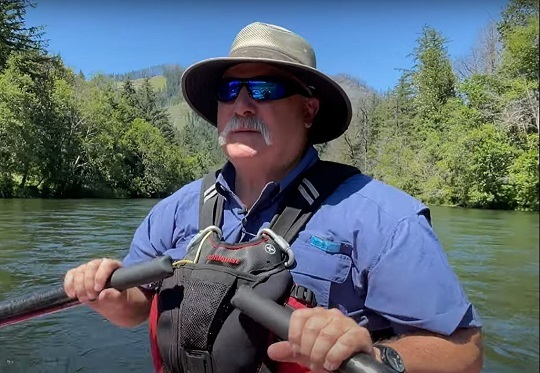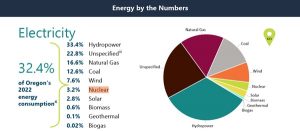Post-fire algae blooms predicted for the McKenzie
4 min read
Unless action is taken, filamentous algae will soon appear throughout the McKenzie River. Outfitter / guide and McKenzie Watershed Protective president Bob Spencer.
[00:00:10] Bob Spencer: How did you like all the houses being built right over the river? You realize that when the water comes up, it’ll be above the foundations on many of those houses?
[00:00:20] From the water line up to the high-water mark, that’s state land. The state owns the river, the river bottom, and they own the land up to the high-water mark.
[00:00:32] The county’s riparian ordinance starts at the high-water mark and goes 50 feet inland. And so all of these houses that you see built on the river had to have exceptions from the county to rebuild. People from out of state are coming in, buying the property and developing that property for revenue— rental income.
[00:00:55] We’re losing our viewshed on the river. We’re losing riparian area. It’s unbelievable that the county would not restrict building in the riparian zone.
[00:01:07] But on the other hand, the county doesn’t do any enforcement or any monitoring of the riparian zone on the river—Eugene’s water supply. They refer it to EWEB. They have a contract with the City of Eugene to provide water and electricity, but they have no statutory authority to do anything to anybody regarding their actions on the river.
[00:01:29] We’ve met with Lane County commissioners. We’ve issued 36 formal complaints between Lane County and the state over riparian violations. Not one of them has been addressed. Not one.
[00:01:43] As, as far as why it’s occurring, why Lane County isn’t acting, it’s all money. It’s financial. If there’s an empty lot on the river—riverfront property—Lane County is making maybe a couple hundred dollars a year in property taxes. Put a half-million dollar or a million-dollar house on that property, and over the life of that house, that’s hundreds of thousands of dollars in tax revenue for Lane County. And that’s precisely why they’re doing it. It’s for money.
[00:02:16] John Q: Up above the riparian zone, the burned area is also being treated with chemicals.
[00:02:22] Bob Spencer: The other concern is what’s going on in these hills here. You know, 175,000 acres of timber burned, and now it’s being cut and the tree farming aspect of it gets started. And with tree farming, they use a lot of herbicides, pesticides, fertilizer, and it leeches into the river. And when that happens, it promotes growth in the river of algae.
[00:02:49] The entire food chain is affected because the river is covered in this filamentous algae. There’s no sunlight getting through where normally there is. Every biological aspect of the river is detrimentally affected because this sunlight that they’ve had forever, all of a sudden it’s blocked and it’s being fed by these chemicals coming down the hills.
[00:03:11] The Santiam River is Salem’s water supply—or, it was. It has become so choked with filamentous algae that they’ve had to go to another water source because their intake plant in Stayton gets clogged with this filamentous algae. And it’s a harbinger of what’s going to happen on this river if something isn’t done.
[00:03:39] It’s a big issue because it has to do with timber companies, the landowners, it has to do with the riverfront property owners. Lane County, in issuing building permits for all these riverfront properties, there’s no language in these new building permits to maintain or enhance the riparian zone.
[00:03:59] So for most builders, that means: It’s scorched earth. It’s fair game. ‘Anything you want to do out there along the river in the riparian zone, that 50 feet: Go for it! Get your excavator down there and strip it.’ And that’s what they do.
[00:04:14] And then right on top of it, they plant grass. How do they keep that grass so green and no weeds in it? Obviously they’re putting fertilizer on it, and it’s just right into the river, and you see it house after house after house. And as you go downstream, it gets worse. You know, those are the issues that we’re trying to educate people about.
[00:04:36] And, you know, if the public knew about this, there’d be a huge outcry. This is Eugene’s drinking water. And with minimal filtration, City of Eugene and EWEB, they’re basically getting free water. Talk to the people in Flint, Michigan, what it means to have good water,
[00:04:55] Getting these government agencies to pay attention? They’re not interested. And like I say, we’ve talked to the county commissioners directly, numerous times. They talk. They talk a lot. But in terms of action, there’s nothing there. You know, we’re kind of sick and tired of talking and it’s getting worse.
[00:05:14] And now that the fire has come through, it’s really focused that issue on what’s going on in the river. But we’re at a tipping point. And if the development continues, the logging, the dumping of chemicals in the forest, and the impact of all those chemicals coming into the river is going to devastate the water supply.
[00:05:34] John Q: For more see the website McKenzieWatershedProtective.org.






